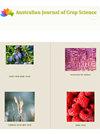Changes in anthocyanins, total phenolics, total flavonoid, and antioxidant activity of Karanda fruit at different stages of maturity
Q3 Agricultural and Biological Sciences
引用次数: 0
Abstract
Karanda (Carissa carandas L.) is mostly eaten raw and contains numerous phytochemicals and high antioxidant capacity. The objective of this study was to investigate the effects of the Karanda fruit’s developmental stages on its phytochemical contents, antioxidant capacity, and volatile compounds. The study herein examined three developmental stages; unripe, semi-ripe, and ripe, based on their stage of maturity as observed in their color and texture. Phytochemical properties; including pH, titratable acidity, vitamin C contents, total soluble solid, total phenolic contents, total flavonoid content, anthocyanin contents, and antioxidant capacity (determined through FRAP, DPPH, and ABTS) were measured. Our results found significant differences in the phytochemical properties in each stage of development. Ripe fruits had the highest pH, total soluble solid, anthocyanin content, and antioxidant capacity determined by FRAP. Thirteen volatile compounds were identified in the fruit samples: eight compounds within the unripe fruits, nine within the semi-ripe fruits, and seven compounds were present in the fully ripe fruits. Alanine ethyl amide and acetic acid were major volatile compounds found in unripe and semi-ripe fruits, whereas tartronic acid was present in the fully ripe fruit. We may conclude that the ripe stage of development, having the highest phytochemical contents and antioxidant activity, is most suitable for harvest and most beneficial for human health. The information obtained in this study will be useful for the efficient utilization of Karanda fruit卡兰达果实不同成熟期花青素、总酚类、总黄酮及抗氧化活性的变化
卡兰达(Carissa carandas L.)主要生吃,含有大量的植物化学物质和高抗氧化能力。本研究旨在探讨卡兰达果实不同发育阶段对其植物化学成分、抗氧化能力和挥发性成分的影响。这项研究考察了三个发展阶段;成熟的:根据它们的颜色和质地所观察到的成熟阶段而定的未成熟、半成熟和成熟的植物化学的性质;测定pH、可滴定酸度、维生素C含量、总可溶性固形物、总酚含量、总黄酮含量、花青素含量和抗氧化能力(通过FRAP、DPPH和ABTS测定)。我们的研究结果发现,在发育的每个阶段,植物化学性质都存在显著差异。成熟果实的pH值、可溶性固形物总量、花青素含量和抗氧化能力最高。在果实样品中鉴定出13种挥发性化合物:未成熟果实中有8种化合物,半成熟果实中有9种化合物,完全成熟果实中有7种化合物。丙氨酸乙酰胺和乙酸是未成熟和半成熟果实中发现的主要挥发性化合物,而酒酒酸则存在于完全成熟的果实中。我们可以得出结论,成熟阶段是植物化学物质含量和抗氧化活性最高的时期,最适合采收,对人体健康最有益。本研究为卡兰达果实的有效利用提供了理论依据
本文章由计算机程序翻译,如有差异,请以英文原文为准。
求助全文
约1分钟内获得全文
求助全文
来源期刊

Australian Journal of Crop Science
农林科学-农艺学
CiteScore
1.20
自引率
0.00%
发文量
75
审稿时长
3.5 months
期刊介绍:
Information not localized
 求助内容:
求助内容: 应助结果提醒方式:
应助结果提醒方式:


